Contents
- 1 How Raul De Lara Carves Radical Narratives Into His Woodwork
- 1.1 Interior Design: Your work seamlessly bridges the gap between functional interior design and sculptural art. How do you approach creating pieces that serve both as practical elements and as artistic statements?
- 1.2 ID: Nature seems to be a recurring theme in your pieces, particularly in your organic wooden forms. Can you speak about your relationship with natural materials and how living between Mexico and the United States has influenced your material choices?
- 1.3 ID: The scale of your work varies dramatically—from intimate household objects to monumental installations. How does your creative process differ when working at these different scales?
- 1.4 ID: What inspired the sculptures for the jewel boxes for SCAD?
- 1.5 ID: What do you think about AI and other high-tech’s impact on art and sculpting?
- 1.6 ID: Your work often incorporates unexpected materials alongside traditional ones. Could you share a particular combination that yielded surprising results?
- 1.7 ID: As someone who creates both commissioned pieces and personal artistic works, how do you balance client expectations with your creative vision?
- 1.8 ID: Which historical design movements or artists have most profoundly influenced your aesthetic approach, and how do you reinterpret these influences in a contemporary context?
- 1.9 ID: You may be the only person in New York who isn’t walking fast. Do you mean this literally?
- 1.10 ID: Looking ahead, what new directions or materials are you excited to explore in your practice? Are there any dream projects you’d like to undertake?
Familia. 2024.
Once as unmoored as his migratory potted sculptures—wooden chimeras caught between house plant and heirloom—Raul De Lara now roots his practice in the uncanny artifice of assimilation, splintering fine art’s polite conventions while exhuming the material memory of immigrant ambition.
The Mexican-born maker, a Deferred Action for Childhood Arrivals (DACA) recipient who is now 33, was evangelized into wood worship as a child playing in the sawdust-shadow of his father’s architecture firm woodshop.
When I visited the Brooklyn-based creative in his two-story studio, my eyes wandered from a photo gallery of suspended sculptures to a lone, dust-covered motorbike—an artifact from the time De Lara pursued a career in BMX, a path derailed by a near-fatal accident that redirected his energy toward carving new narratives into snow shovels, chains, and chairs—household objects retooled into quietly radical vessels of memory and meaning.
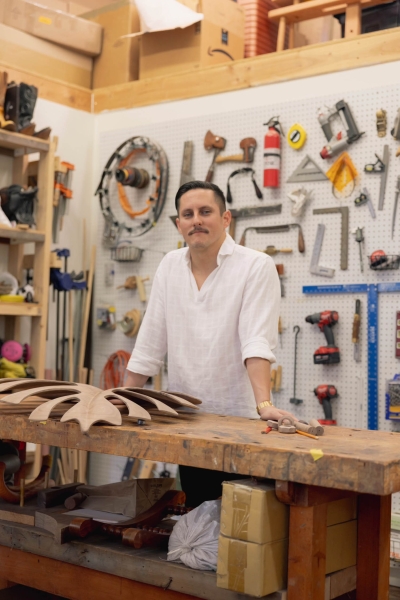
Raul De Lara. Photography by Hannah Edelman.
How Raul De Lara Carves Radical Narratives Into His Woodwork
Interior Design: Your work seamlessly bridges the gap between functional interior design and sculptural art. How do you approach creating pieces that serve both as practical elements and as artistic statements?
Raul De Lara: I look at how things are made structurally. Part of my life’s work is the mastery of woodwork. But what challenges woodworking, sculpture, and design for me is that I give you just enough hints of multiple worlds to be unsure where the piece falls. The pots, plants, and hardware that I make and you see—the fact that it has those queues threaded together and it’s very pronounced—forces you to ask the following questions: Is this for me to use? Is it finished? Is it ever done? Does it move? I like playing with cues that hint at multiple worlds.
For example, I think the Tired Tools are a pretty direct thing. I am using the language of a tool. I push it just far enough—surreal, but real enough—that it could pass as a true industrial product. We both know though that it’s not, how do you say “living”? Even with the chairs—I was in an architecture class in my last semester in college. But conceptually, we both know it’s not living, in the it’s going to move in front of you way.
When I carved these cushions for the Soft Chair—it’s not like it’s right or wrong—it had the essence and presence of softness. But it couldn’t be more wood. There’s not a trick here. You see every year of life on that wood. There’s no hiding.
ID: Nature seems to be a recurring theme in your pieces, particularly in your organic wooden forms. Can you speak about your relationship with natural materials and how living between Mexico and the United States has influenced your material choices?
RDL: Plants are a recurring theme in my work: the leaves, the cacti. I use them depending on the poetry or strategy I’m after. With the left-handed school desk I made in small scale—gesturing to a hazy childhood memory, the haziness of how big or small things looked—I use that awkward scale. I am referencing the awkwardness of growing up as a queer, left-handed kid in a Catholic school in Mexico.
With the chair—that represents aggressions, awkwardness and being timid. The cacti represent those themes because they are beautiful, but you can’t touch them. Passion or affection is shunned for embracing something. With cacti you can’t, or at least you shouldn’t, touch them. They’re a funny metaphor and a big part of my work.
As for the leaves, I went to Central Park in the fall to find a white oak leaf, walking the entire park, corner to corner. I found one near the ice skating rink after scouring hundreds, seeking to identify the most perfect, attractive leaf to me. I found those shapes, brought them into the studio, and carved them, recording my life through those shapes.
In nature, there are works that mimic a sensation. It’s also hard to put words to feelings, harder still to put shapes to feelings. How do you create an awkward sculpture or a proud, mysterious sculpture? These objects—furniture and sculpture—are familiar entry points into people’s psyches and communicate how—with the plants, for example—I can’t set roots in this country as a DACA person. I am allowed to be here, but I can’t fully be here. I also can’t go home or fully be home. Instead, I am stuck here in this container of growth: where the containers and plants originate.

19 Years So Far / 19 Años Después. 2023.
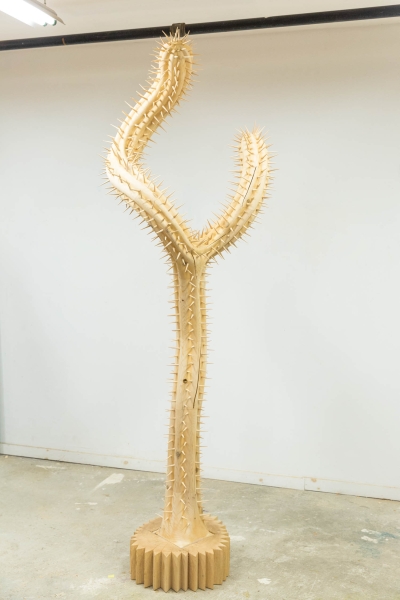
Saguaro #2. 2021.
ID: The scale of your work varies dramatically—from intimate household objects to monumental installations. How does your creative process differ when working at these different scales?
RDL: I make sure I pack a punch in every inch. It’s easy to fall into the trap of thinking that creating something large is inherently good. I don’t like to use the word “good.” I prefer words like active, engaging, or hypnotic. I enjoy the work of Urs Fischer with the clay he squeezes to become four-story monuments; it’s so crazy and yet so banal. Look at the banana from the Upper East Side street vendor that sold for millions—is that art too? Everything has to have a purpose. It’s why I try to not use anything unneeded internally or externally—and this purity, it is what it is, and it has a purpose. This is where industrial design falls into place in my work. My actions are driven by research, purpose, and something concrete (no pun intended); and some choices are driven by humor… These “Tired Tools” become portraits of untold labor.
ID: What inspired the sculptures for the jewel boxes for SCAD?
RDL: These are glass vitrines that are two to three stories high. The show is called “Raíces,” or “roots” in Spanish. This past year, 2024, was one of the most impactful years of my life. I was finally able to return to Mexico for the first time in 20 years. It was a blessing and a curse. I could go because my grandma was passing and applied for a travel permit called “advance parole.” Welcome to DACA news. We can leave, but we can’t come back—unless we apply for this permit. In the interview, you have to prove that the person is dying. And, the officer asked, “So why do you have to be there if all your family is over there with your grandma?” I responded with humor because what else can you do: “Well, because I don’t know when she’ll die again.” I gave her the same type of answer as her question.
Going back to the SCAD show, though, that trip gave me the emotional acceptance to move forward. A lot of my career deals with what happened to me. Now it’s about my future. For SCAD, I wanted to bring that excitement, closure, and beginning. I made a very large sculpture for that show, and I am most impressed by it—a wooden pot on a pedestal with two huge monstera leaves, exact replicas of ones I saw in Mexico City. It’s titled The Ones Back Home, and it is tailored to the jewel box window scale. Many of my works hinge on mastering a technique, and extend into a skill and material dexterity and curiosity, because when you see that much wood carved, it has a different, strange presence. The Ones Back Home is nine feet tall, and I sketched the design in virtual reality and traced it onto wood with the VR headset on.
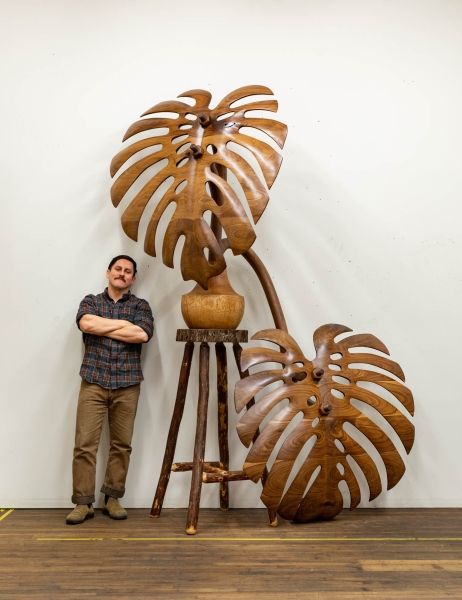
Como Las De Mi Tierra / Like The One’s Back Home.. 2024. On view now at SCAD Museum of Art as part of the solo exhibition “Raul De Lara: Raices/Roots” from January 15 – July 6, 2025.
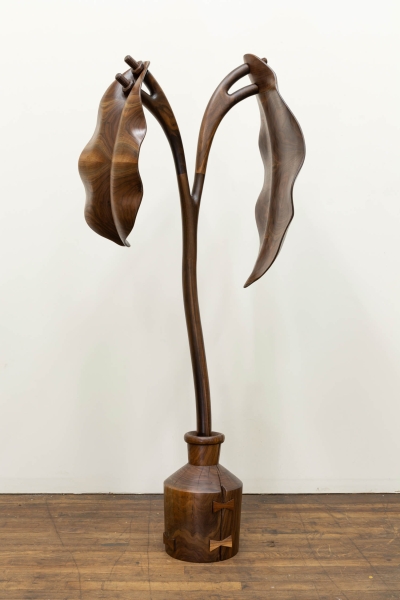
Pending Flowers. 2024.
ID: What do you think about AI and other high-tech’s impact on art and sculpting?
RDL: The design wasn’t the result of virtual reality. I just happened to find another unintended use for this 3D sketchbook. But to be able to use my body to bridge the gap between digital reality and produce real results, I didn’t have to learn any software and go through all these clicks and buttons; it was like action! The technology wasn’t the one doing the work; it was me. I am not a hater of fabrication, but I think there’s a distinction between sculptures made of wood and wood being sculpted. All these people making busts out of marble, but it’s just a bunch of clicks and 3D renderings that end up happening to be marble. That was never a conversation with marble. They just abused a piece of marble. There was no dialogue with the marble. There’s no discovery. It just happens to be marble. People are giving too much agency and control to machines to make something. How boring!
RDL: I once pulled a tooth out to create a sculpture. I didn’t lose the tooth since I got it pulled out by a dentist.
I got my first exhibition ever in Mexico in 2020, and I thought “What the [expletive] do I have to say back home?” If we ever got a message from the aliens, what would they say? And, whatever they say is probably going to be crazy and meaningful in some way. So, I thought, whatever I say will be stuck to me and will be meaningful. I made two pieces, one represents the piece with the tooth, and the other my current state of confinement—but I can still grow upwards.
For me, that show meant a lot. Because I couldn’t go, a friend from P-town offered to go to the show on my behalf, introducing himself as me, even though he’s tall, blue-eyed and from Wisconsin. It gives me chills. I FaceTimed him, my grandpa, and family while he introduced himself to the gallerist and clients as me. They all knew, but he was my spiritual representative and this is the legal reality that we had to dance our way out of. So, that is my unexpected material.
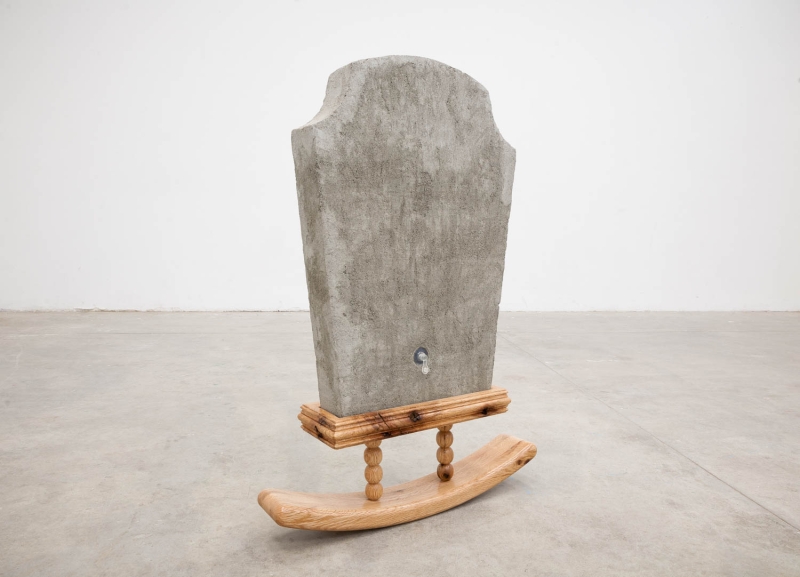
Inflatable Tombstone. 2019.
ID: As someone who creates both commissioned pieces and personal artistic works, how do you balance client expectations with your creative vision?
RDL: I think the reason it gets good traction is because I have good conversations with people in the design world, the sculptural world, and the poetry world. I don’t limit my curiosity to one field. But I follow many routes. I think about it poetically—how do you depict life, how do you depict death. In Mexican tradition, skull masks are very much a tradition you see in all kinds of things.
But an art historian can research the wood and beans that I used—the hallucinogenic factor those legumes have—and there’s a way to carve that mask through those beans, through this Mayan process that is still used in the community. These beans can kill you, and it’s a well-guarded technique. The wood I had to go harvest in Mexico; you can’t buy it. To bring it to the U.S., I had to find a person who lived in the forest in the region where the trees grow. My dad had a friend who sent a block of wood and painted a solid color with the words “live, love, laugh” because it didn’t matter, I was going to carve away when it got here. But that color, those words: that made it art. Looking at the weird, magical reasons these beans exist.
Career and art objects are first. Commissions, obviously, come more frequently now. I don’t take all commissions because I don’t want to make something that doesn’t align with what I want to make. I can tell you a story for an hour about a sculpture and ultimately you see the finished product and think, “It’s just a chair.“ I think it’s about the life of the object itself. I take proposals as a question: Would a saint live in this thing? Am I doing justice to the tree that died for this reason, to end up in my studio?
ID: Which historical design movements or artists have most profoundly influenced your aesthetic approach, and how do you reinterpret these influences in a contemporary context?
RDL: Robert Gober is one of my all-time favorites. I saw a wedge of cheese human hair with hundreds, if not thousands of hairs, embedded in it and slicked back—Gober has this way of making these exact, fabricated objects.
Martin Puryear, a wood sculptor, is someone who I very much love and respect. He looks at an object with intention in every inch, not to mention the way he respects the material.
Regarding the design world, I enjoy Charles and Ray Eames, who said “Take your pleasure seriously.” I thought “Wait, yeah!” Even work can be a pleasure. They have a spirit of playfulness that I’m all about. It made me think , “Oh, yeah, that’s a way of life.”
Gaudi, the architect—in the making world, I can wrap around a lot of things, but I can’t make sense of him. If I had to give instructions on how to make the things he did, my brain shuts down. The Sagrada Familia—so magical, strange and playful— whatever that energy he carries, I’m into it. I’m fortunate enough to be receptive to the world and I walk through it slowly. Because I think everyone has something to share.

Familia. 2024.
ID: You may be the only person in New York who isn’t walking fast. Do you mean this literally?
RDL: It’s funny you say that, I thought my whole life I’d never live in New York because I hate walking. In grad school, I told my family that you’ll catch me dead before I move to New York. With what I do in my sculpting career, I stand all day. The idea of doing what I do all day and then walking with my groceries and walking with my tools—that sounds like a nightmare. I do have a car and a motorcycle. Now living here, I have come to respect walking and use it as a tool.
ID: Looking ahead, what new directions or materials are you excited to explore in your practice? Are there any dream projects you’d like to undertake?
RDL: This year I have three museum shows, the solo show at SCAD Museum, a group show at Tucson Museum of Art, and a solo show at the Austin Contemporary in September. I love the desert, and I have all these shows in places where I have an affinity. The desert is a big part of my work. This year, I’m excited to see what’s next in my work. A lot of my art practice has been about who I was, what made me, what happened to me, where I come from, who was involved, and what was said.
For the past few years, I’ve said I want to make abstract work. But I think that was a way of saying I wanted to transcend the idea that I am the past. It’s more comfortable to know who you are than not to know. But that’s what I’m excited about now— trying new materials and techniques. My trip to Mexico this past year helped me move on as an artist. I can’t tell you what it’ll be in the next year, but I can tell you it’ll be exciting. I am not done with wood. My whole life has been training for this.
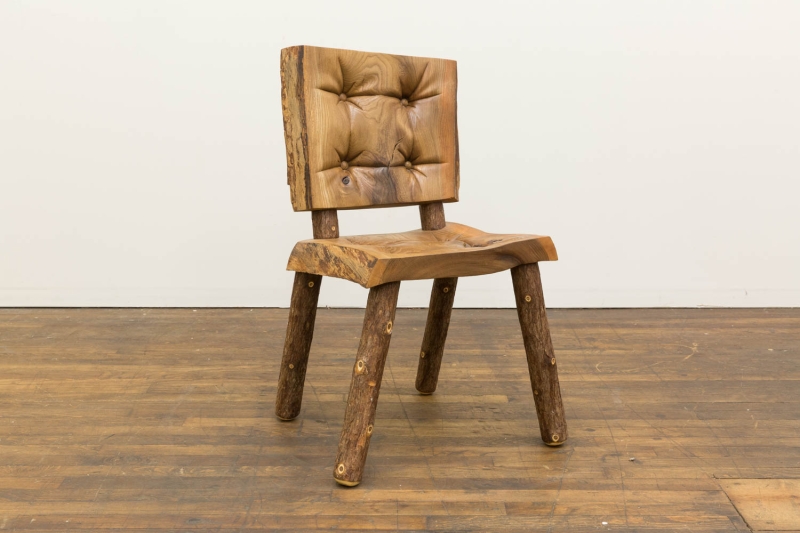
Soft Chair. 2023.

